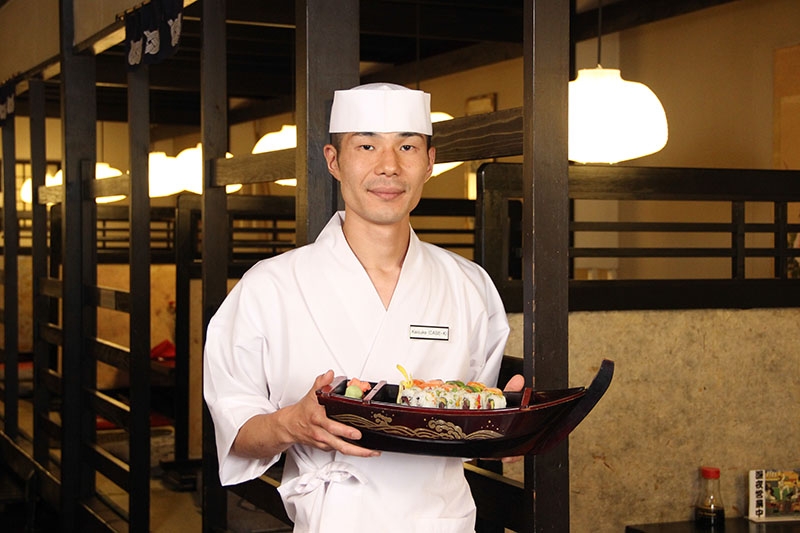
Shogun: Rolling Out Tradition
Food Reviews
Lunch: Monday–Friday, 11:30 a.m.–2:00 p.m.
Dinner:
Sunday–Thursday, 5:30 p.m.–10:00 p.m.,
Friday–Saturday, 5:30 p.m.–11:00 p.m.
Late Night Izakaya: Tuesday–Wednesday, 10:00 p.m.–12:00 a.m.
Late Night Happy Hour:
Thursdays, 10:00 p.m.–1:00 a.m.,
Friday–Saturday, 11:00 p.m.–2:00 a.m.
Living where we do, especially 30 years ago, Utah could have been comparable to creative eating’s desert island. Funeral potatoes, white bread, Jell-O and Flock of Seagulls were fully stocked, while international flavors were still making their way into our landlocked hearts.
If a James Bond–style story isn’t the most badass way to tell how traditional sushi made its way into the state, then we might as well be critiquing the evolution of a Mormon tuna casserole. It all started with a man named Toshio Osaka, aka Sensei, and his special assignment from the FBI to teach Japanese martial arts in our little dust bowl. The bar at 321 South and Main, first dubbed Sushi of Asakusa, has been making and preserving history since it first opened shop in 1983. In that time, no ball’s been dropped, and today, it is Shogun.
That’s just scratching the surface. While Sensei made it happen, his good friend and first chef, Shinpei, now deceased, had the dream to make Shogun what it is today. These are all the testaments of Keisuke Sasaki, Shogun’s current, only and veteran sushi chef of eight years out of the 10 that he’s been rolling professionally. Making his way from Shizuoka, Japan, Keisuke studied food and nutrition at Southern Utah University, but came to SLC so he could play punk in his former band, The Willkills. Sasaki now rips guitar in All Systems Fail when he’s off the clock.
Sasaki will be your man any day of the week, but if you’re looking for the experience, Friday and Saturday happy hour ‘til 2 a.m. will be the busiest and best time to get your fix of Slayer and J-pop while you enjoy the freshest cuts in town camping out in one of Shogun’s authentically crafted dining rooms. “These booths are very special,” says Sasaki. “They were built by a Japanese carpenter and constructed without any nails in the traditional fashion, the same as you would find in traditional architectures in Japan.”
For a quieter or more date-night feel, I’d suggest starting an early to midweek dinner ritual. Regardless, a Mexico Roll ($8.00) paired with the Sunrise ($12.00) and some Hot Sake ($5.95 small, $8.95 large) are where you should start. The Mexico, with its spicy tuna, cilantro and avocado rolled then coated in crushed Thai chili, will kick your ass, as it combines traditional meats with the spice and improvisations of sushi chefs from around the world. “American sushi has developed with so many unique ideas for their presentation … [It has] been evolved by many different cultures and people,” says Sasaki.
Once I settled into my first bites of crisp, herby fuego, my mind was cleared with the sharp jab and smooth vapor from a sake sip before I lightened up with the Sunrise. Prominent yet clean, the Sunrise is a crab and avocado roll topped with sliced tuna and very thin lemon. It’ll mellow out the intensity of the Mexico as the crab and avocado cream together, allowing for the salmon and lemon to collaborate. Combined, the roll’s essences fly in a silky zing that finishes neutrally enough to start the journey again.
So far, I’ve been eating straight raw—but what if you’re leaning toward sweet and savory? Try the Tiger ($10.00). It all starts with a butterfly of shrimp tempura, the multipurpose avocado wrapped in rice and nori then drizzled with eel sauce. I always like something fried when I buy rolls because it lets my taste buds go off on a tangent in between appreciating more gentle cuts of raw fish. The Tiger is no exception. I’m immediately graced with a meatier and crunchy tempura mouth feel, which is complemented by the avocado. Pouring on some salty soy sauce, the sweet eel drives the whole point home.
Throughout the years, Shogun chefs have come, grown and gone on to more independent endeavors—as do most devoted professionals. Some of the local talent who’ve sharpened a knife or two behind the bar at Shogun include Tetsuro Abe, a Sushi of Asakusa opening chef and now owner of Salt Lake’s Ginza on 200 South, and Takashi Gibo, owner of Takashi on Market Street. “Probably the most successful chefs from Shogun is Masato Nakabayashi, who is now one of the executives of Buddha Bar in Paris, France. He’s in charge of the company’s projects in all of Europe and still comes to see Sensei when he visits the United States,” says Sasaki.
Building a reputation like Shogun’s only comes with skill and perseverance, which is why Sensei and Sasaki are always setting their sights higher. “We are currently getting ready to start hibachi again, [which] we haven’t done in 10 years,” says Sasaki.
With new dining options in the making, a first-class sushi bar and a mix of authentic Japanese entrées, it seems that Shogun is forever sticking to their roots and originality. It’s a wonder that places like this can exist so far away from the ocean and still do nothing but deliver. Visit the establishment and support one of Utah’s first Japanese restaurants. Roll on!